BEE MAY 2014
Birds and Bees and Trees, Oh My! — Sierra de Guadalupe
Love is definitely in the air. The male Hooded Orioles, Northern Cardinals and House Finches have been singing their hearts out this past month in the Ficus benjamina and Jacaranda trees in the garden. And the Ospreys seem to have finally settled down with their respective mates in one of several nearby nests.
Until recently, one pair of these large fish eagles were working hard on a new nest on top of the power lines across a small canyon from us. Over a few days, intermittently one or the other osprey could be seen swooping low past the dining room window, weighed down by a huge branch in its talons. Occasionally, it would have to stop flapping briefly to readjust its load before continuing on its way to the new nest. And for several weeks, one bird or another would sit on the power pole located just on the other side of our wall, and on and off throughout the day call in a high-pitched, shrieky, almost fingernail-on-chalkboard manner. Endearing? Maybe not so much, but they are incredibly gorgeous birds. One local character can be seen regularly in the morning or evening perched on the rail of the highway bridge near downtown where it crosses the river, looking for prey far below in the water. It seems unperturbed by the semi trucks and cars roaring past.
The Carpenter bees (possibly Xylocopa californica) are also busy. These huge, iridescent black insects build nests in exposed wood, such as roof beams and posts. They also like dead palm trunks that are commonly used here for posts. They are considered to be pests because of the structural damage they can cause, but they are very interesting to observe and important desert pollinators. Apparently it is the male bees that hover at the nest entrance, protecting it and agressively chasing away other bees and even people who get too close! The antics when one male is chasing off several other carpenter bees is quite entertaining as they bob and weave all over the place, appearing to be drunk and unwieldy fliers. Fortunately the males don't sting, and the female is apparently reluctant to do so unless handled. Now that they are mating and nesting, they can often be heard buzzing around the house, looking for mates and new nest sites under the eves, no doubt. There are many on-line fact sheets and here is a good example.
Here in Mulegè, we don't have spring wildflower shows like those seen in the southern California deserts or in the Vizcaíno Desert less than 120 miles north of us, where spring wildflowers may bloom in late February and early March, many of them in the coastal and inland sand dunes (see below). However, this year we saw no evidence of the sand verbena and other tiny annuals on our trip to the area in late February to see the Gray Whales (read more about Mexico´s Gray Whales at my page).
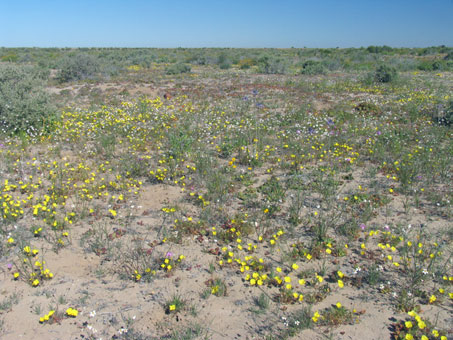
Vizcaíno Desert at El Arco turnoff (Feb. 2008)
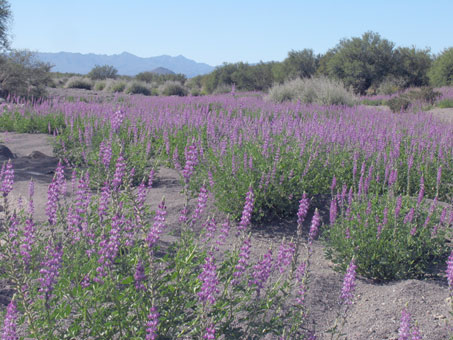
Lupines in Vado Lester, near Ejido Bonfil and Volcán las Tres Vírgenes (Feb. 2008).
Around Mulegé, most annual flowers and many shrubs and trees bloom as a result of the late summer rains July to September. They may continue into October or even November during good years. You can go here to see my images of the desert after Hurricane Jimena in 2009.
Our spring flowering is more subtle and extended, with the cactus leading the way as the Cardón (Pachycereus pringlei, Cactaceae) bud as early as the end of February in some places, and flower beginning mid to late March. The Cardón on the slope in front of our place are packed with buds and flowers for the 3rd year in a row, which is surprising since it's not uncommon for the Cardón to skip one or more years between flowering to replenish energy stores. No doubt, the 2012 and 2013 summer rains are helping greatly. The plants are also looking very healthy and fat for this time of the year.
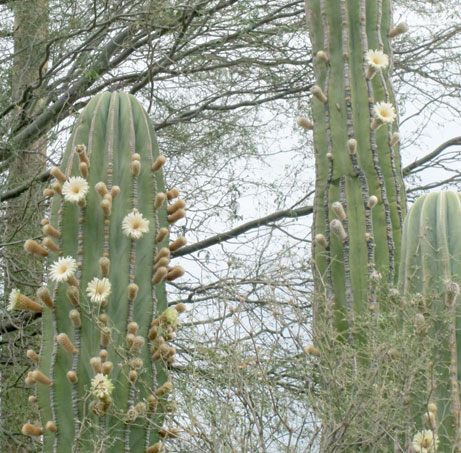 Cardón (Pachycereus pringlei) blooming in early April.
Cardón (Pachycereus pringlei) blooming in early April.
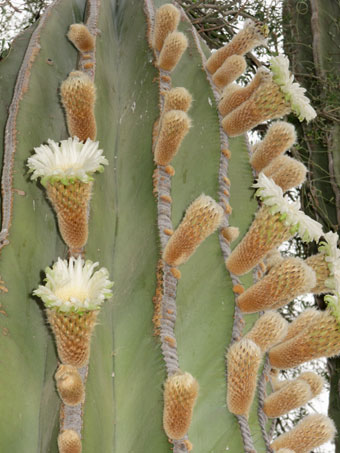 Cardón flowers in early April.
Cardón flowers in early April.
The flowers occur on the upper third or so of the stems in an arc of 270° between NE and NW. This species is trioecious, meaning that flowers can be of three reproductive states: female, male or hermaphrode (bisexual).
Of the gazillions of photos that I've taken, I'd have thought that I would have more variety in the sexes of the Cardón flower images, but so far I've only found one male, several female, and many hermaphrodite plants (above two images) in my image collection.
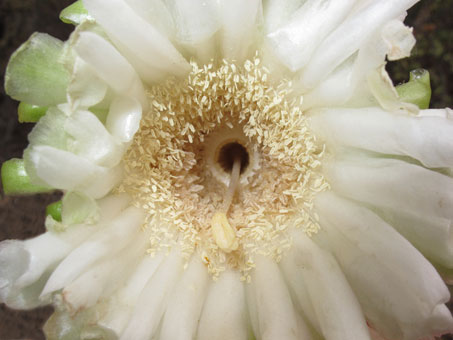
Closeup of a hermaphroditic (bisexual) flower. The pistil (female reproductive structure comprised of the ovary, style or stalk, and stigma or receptive tips) and the stamens (male structure with pollen bearing anthers on) are all functional.
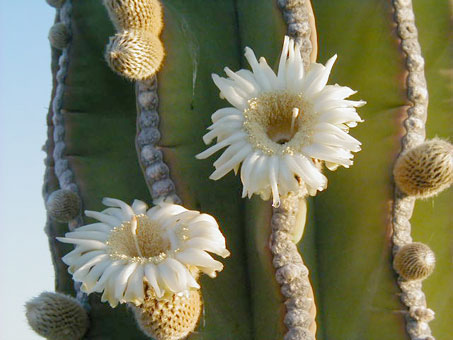
I think these are pistillate (female) flowers. From what I´ve notice, they usually have a shorter tube, the bulge of the ovary is already visible at flower opening, the perianth is distinctly folded back (reflexed) and the stamens are tan, rather than pale yellow (2003).
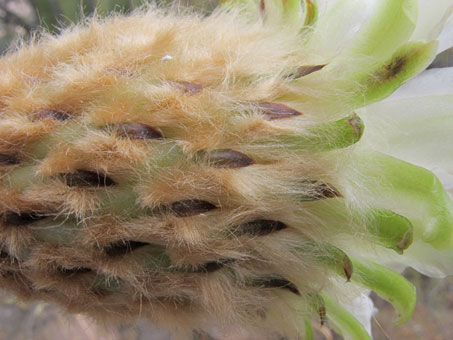
The outer perianth parts of a (hermaphroditic) Cardón flower are tan or maroon in the lower part of the flower and grade to green. The inner perianth parts are white (photo, left). I forgot there are some sparse, small (sharp!) spines hiding in those wooly hairs.
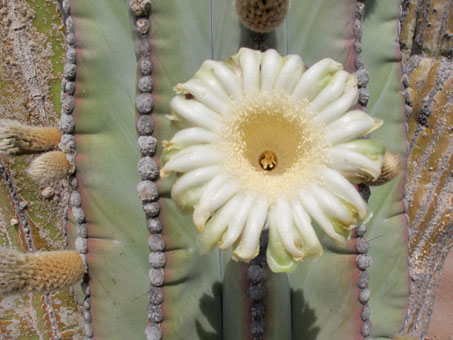
Staminate (male) flower. The pistil is poorly formed, barely protruding from the narrow tube in the flower base. The perianth parts are rotate (about 90°). You can see the lack of an ovary bulge in the spent, lower and upper flowers on the left (Mar. 26).
The other early bloomers are the two species of Palo Verde, both leguminous trees or shrubs (Fabaceae). Little-leaf Palo Verde, known locally as Dipúa (Parkinsonia microphylla) is the common, widespread, native, desert species while Mexican Palo Verde, here known as Junco or Junco Marino (Parkinsonia aculeata), is native to Mexico and is a common ornamental tree, readily escaping into riparian as well as disturbed areas around habitation.
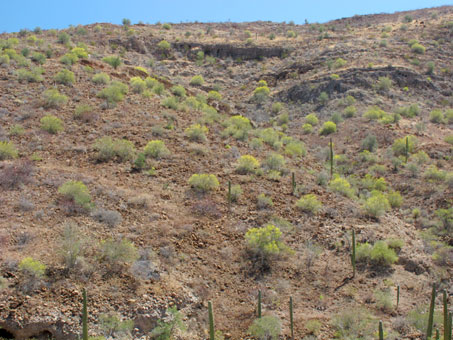
Dipúa or Little-leaf Palo Verde (Parkinsonia microphylla, Fabaceae) starting to bloom around Bahía Concepción (Mar. 31).
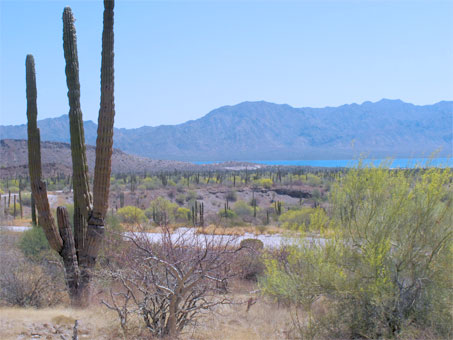
View of Bahía Concepción through the blooming Dipúa or Little-leaf Palo Verde (Parkinsonia microphylla, Mar. 31).
Both trees are drought deciduous, and photosynthesize most of the year through the tissues of their bright green stems and branches. Dipúa lacks spines but has spinose (pointy) branches, and as the name implies, very small leaves (each rachis is about 2 cm long and the pinnate leaflets 2 to 3 mm long).
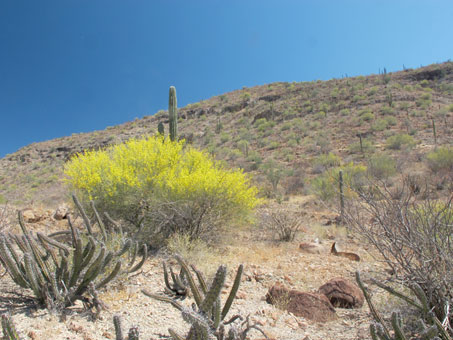
Lone Parkinsonia microphylla in full bloom. Others nearby were just starting to bloom. The tree was abuzz with bees and wasps.
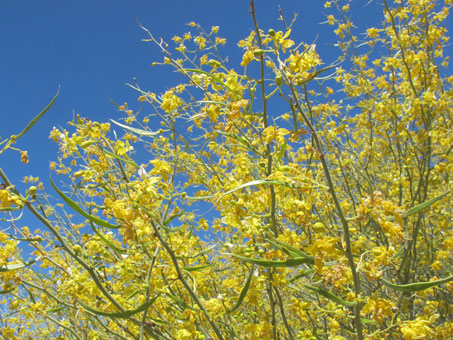
Tiny green beans can be seen poking out of these Parkinsonia microphylla flowers.
Junco has small spines along the stems at the base of the leaves. Each central stalk, or rachis, is straplike and 20-40 cm long and has tiny, pinnate leaflets 3-6 mm long widely spaced along it. The leaves give the plant a very wispy silhouette.
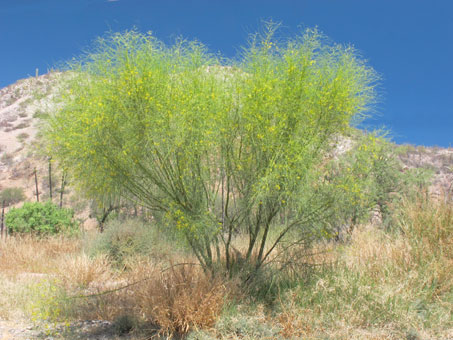
Junco or Mexican Palo Verde (Parkinsonia aculeata) growing at the edge of an abandoned palm orchard along the river.
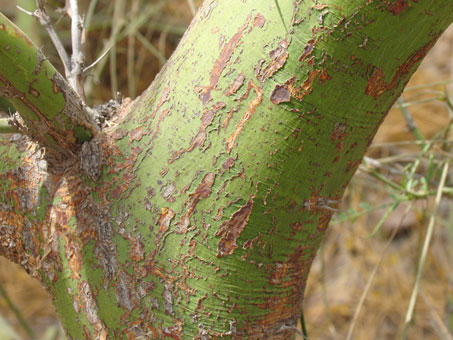
Trunk of Parkinsonia aculeata. It has a deep, lime green colored bark while that of P. microphylla is much paler.
These species are in the subfamily Caesalpinioideae, which is usually characterized by flowers with 5-petaled, bilaterally symmetrical to irregular flowers (see images below) that have a "standard" (upper) petal and 4 more or less similar "lower" petals. Both of the Palo Verdes have clear, yellow "lower" petals.
The Dipúa's standard petal is white and after the flower is pollinated, it turns yellow like the rest. The Junco, on the other hand has a yellow standard petal with orange specks near the base (claw) and it darkens to orange or sometimes deep maroon after pollination.
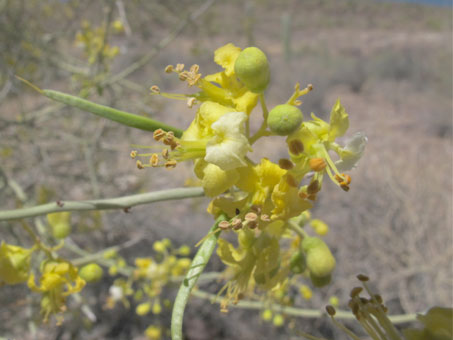
Parkinsonia microphylla flowers. Note the newer flower on the right with the white petal and fat, orange anthers. The other flower with a white petal on the left has anthers that are drying up. The flower in the middle has faded and now has a yellow standard and shrunken anthers. Beans are sticking out at 7 and 10.
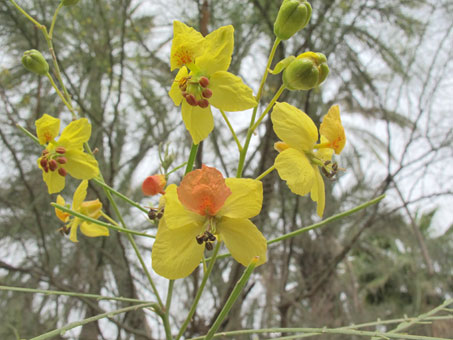
Parkinsonia aculeata flowers. The three flowers and two buds on the right are on one infloresence. The oldest is below, with a dark orange standard and shrunken, dark anthers. The middle flower´s petal is turning orange while the upper most flower is still viable, with a speckled yellow standard and plump orange anthers.
 It´s very dry here in Mulegé as I write this. The warm, northerly winds on and off throughout the months of March and April have certainly taken their toll. Though we do have the "off" parts, when it´s hot and damp instead. These are the times in the evenings when, as the wind drops and the humidity suddenly shoots up, the smell of damp creosote bush or Gobernadora (Larrea tridentata, Zygophyllaceae) will waft in through the open windows while the electrical transformer just a few yards down the hill starts to crackle and pop ominously. That's the time to mentally review the location of the flashlight and candles before relaxing and enjoying the heady odors of a warm desert night.
It´s very dry here in Mulegé as I write this. The warm, northerly winds on and off throughout the months of March and April have certainly taken their toll. Though we do have the "off" parts, when it´s hot and damp instead. These are the times in the evenings when, as the wind drops and the humidity suddenly shoots up, the smell of damp creosote bush or Gobernadora (Larrea tridentata, Zygophyllaceae) will waft in through the open windows while the electrical transformer just a few yards down the hill starts to crackle and pop ominously. That's the time to mentally review the location of the flashlight and candles before relaxing and enjoying the heady odors of a warm desert night.
Around Mulegé — May 17
There has been so much to see this year, and so little space and time to show you. So I'm going to present a few unrelated items this time.
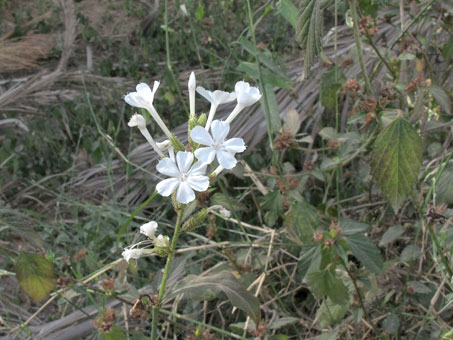
Plumbago zealanica (White leadwort, Plumbaginaceae). This perennial herb is native to SE Asia, yet seems to do well in riparian areas of the the southern peninsula. It's more common upstream from Mulegé in the arroyos of the sierras.
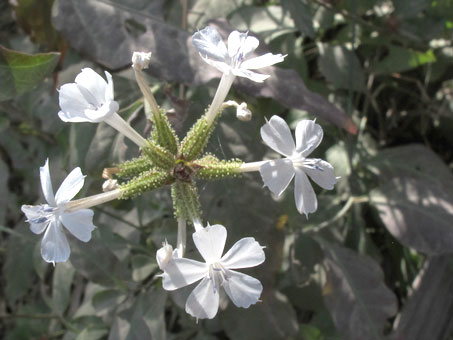
This plant was well hidden from the browsing beasts and I was lucky to get both specimens and photos over an extended period. The flowers are about 1.5 cm in diameter and the anthers are a lovely shade of blue. The calyx has long, stalked glandular hairs.
Sierra de Guadalupe
In late February, we took a day trip up to the mountains to see what we could see. The road has been in excellent shape for the last two winters, after it was wreaked by the heavy rains from Hurricane Paul in 2012. The road is narrow, mainly one lane most of the way, with some wide spaces here and there in case you meet oncoming traffic. In the 6 hours we spent that day traveling only 25 miles each way, we met two cars, one of course as we were climbing a steep, loose grade around a corner. But other than that, we could have been the only people on the planet.
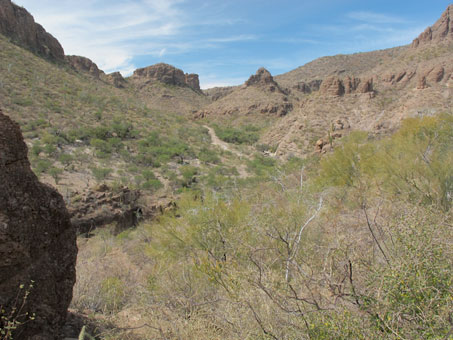
Road climbing up the east escarpment of the Sierra Guadalupe. Elevation is about 250-400 meters (800-1300 feet). Here, the road follows the path of a deep canyon (arroyo).
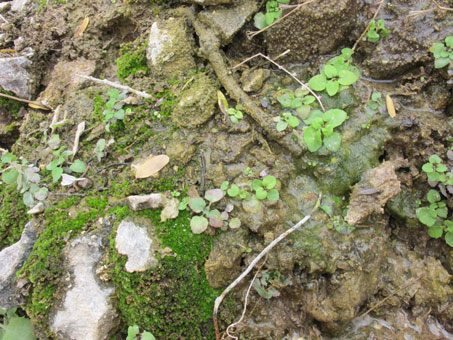
There was a plant that smelled & looked just like peppermint in the pool, as well as Mimulus brevinasuta, Eleocharis geniculata, & at least two moss species, which also grew above along the seep.
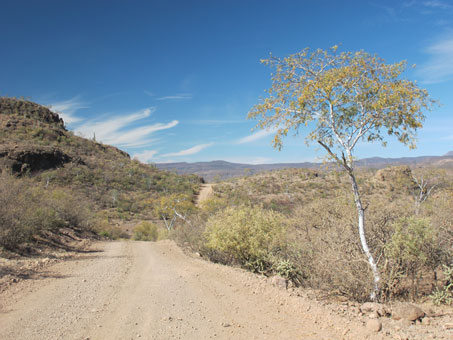
Here, we've crested the mountains and are looking to the west. Local friends told us that this is more or less the point where the arroyos flow to the Pacific Ocean instead of the Gulf.
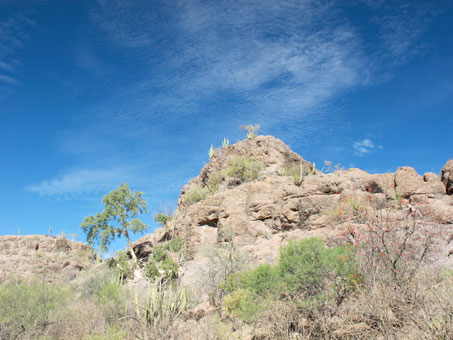
A large Zalate or Wild Fig (Ficus palmeri, Moraceae) growing on a rock face. The roots are growing across the rock surface and are wedged into cracks where they can. These trees are amazing and beautiful. The figs, which are only about 1 cm in diameter are dry and inedible.
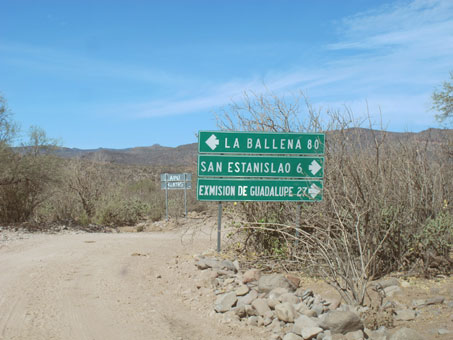
Uh, oh, which way to go? We decided to go left, as we´d heard that the way to the old mission was in pretty bad shape. La Ballena (the Whale) is almost at the Pacific coast, 48 miles away.

We stopped in the only shady place around, under the dense canopy of Mesquite (Prosopis articulata) and Condalia brandegeei (Rhamnaceae) trees. There were even picnic tables and an above ground barbeque stand!
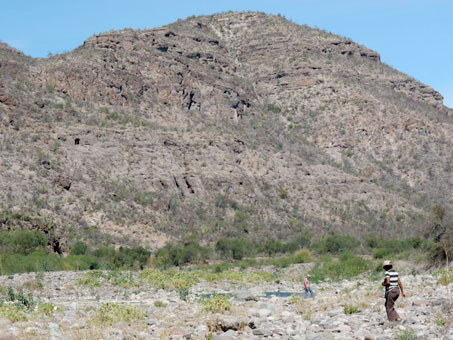
I could hardly see my friend in the distance until I used the telefoto. She had found, and was collecting, an aquatic plant for me.

There were three or four hydrophyllic herbs that I also know from along the riparian area near the Ojo de Agua in Mulegé. Stemodia durantifolia (no local name, but known in the US as whitewoolly twintip for reasons that are beyond me!).

and Petunia parviflora (Solanaceae), also seen last year in Mulegé. The flowers are about 5 mm D and the leaves are quite thick. Though it's known as Seaside Petunia, it is a long way from the ocean here.

The Panteón de San Miguel (San Miguel cemetary) was through the trees a short distance from the picnic area. We couldn´t see any dates on the old graves (piles of rock). Our friend said that people from nearby ranches have been buried here for a long time.
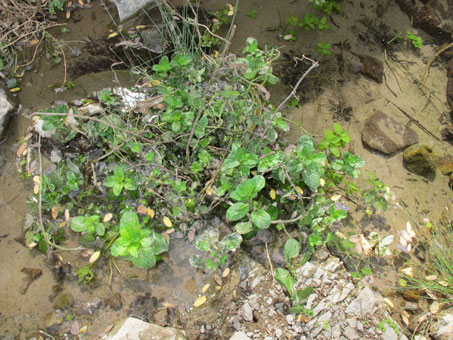
As we were climbing, we came to a place where a small watercourse crossed the road, originating from a widespread seep in the cliff and hillside above the road. At the base was this small pool.
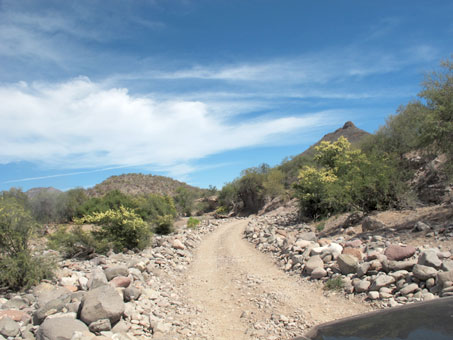
Flowering Huisache (Acacia brandegeana, Fabaceae) on both sides of the road. Down in the Mulegé valley, it's too early in February for this endemic shrub/small tree to flower.
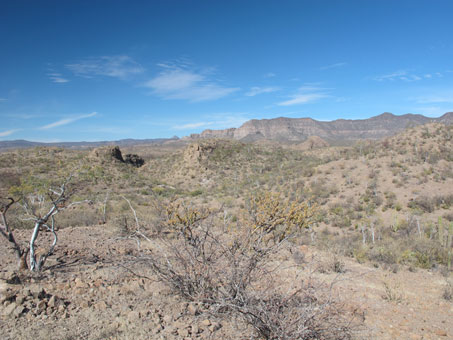
The road goes up and down like a small roller coaster for a number of miles across a plateau-like area.
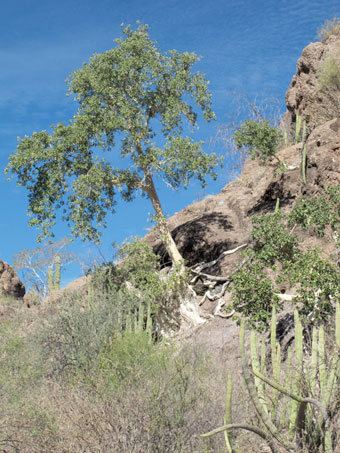
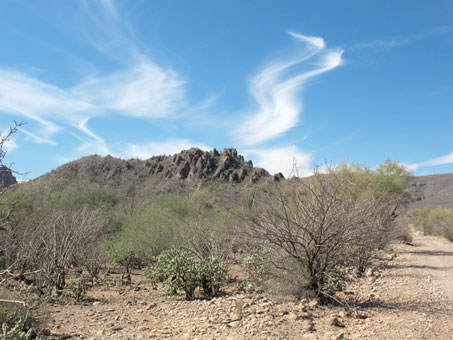
An interesting ridge in the distance. The eroded, vertical slabs give it a prehistoric look, like the back of a dinosaur. This part crosses a bajada with many species also typical of the Mulegé area.
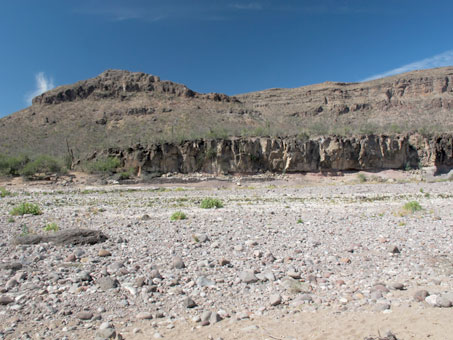
The picnic area was on a silty terrace just a meter or so above the enormous Arroyo San Miguel. The scale here is hard to see, but check out the next photos. It's more than 100 meters wide from here to the 15 meter high cliffs.
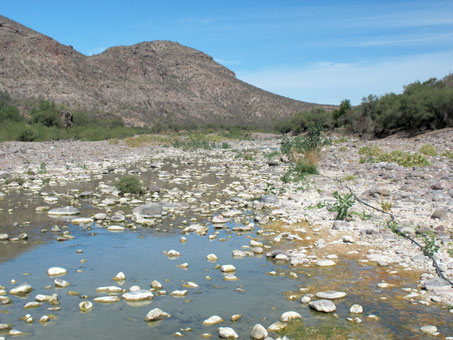
There were small, shallow ponds and water flow was visible from the right edge of the arroyo towards here.
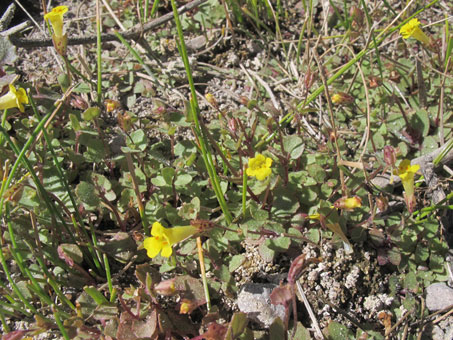
Many-flowered Monkeyflower (Erythranthe [Mimulus] floribunda, Phrymaceae) formed mats on the edges of a couple of ponds, along with Water hyssop (Bacopa monnieri), Bent spikerush (Eleocharis geniculata)...
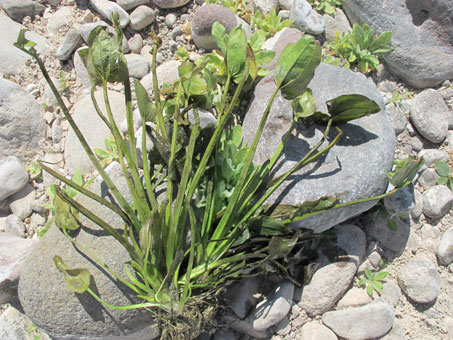
The obligate aquatic plant my friend found, Echinodorus berteroi (Water-plaintain, Alismataceae), was fully rooted in the bottom mud.

Part of the cemetary was surrounded by a very old rock wall, constructed with the local lava blocks that can be found almost everywhere on the volcanic slopes. We wondered if it dated to the times of the old Misión San Miguel that used to be located somewhere closeby.
It was a great trip up into the Sierra Guadalupe. None of us had ever gone as far up into the mountains before. I was constantly on alert for unfamiliar plants, but what I saw instead as I drove was a slightly different mixture, or composition, of most of the same plants familiar to me down near sea level around Mulegé.
The vegetation in the Sierra Guadalupe area is classified as part of the Sierra La Giganta floristic region, meaning that there are many differences in the species and plant communities compared to the Central Gulf Coast region. No doubt, if we make another trip in October or November, closer to the time of the late summer rains, we will find many unfamiliar plants with leaves and maybe even flowers to help us identify them.
We were all tired from getting bounced around inside the car for most of the day, but we returned to town quite content in having explored new territory and experienced the incomparable beauty of the sierras.
That´s it for now. I´ll be wrapping up the field season next month, as we head north for the US again. Hopefully there will be lots of lovely plants to report on. Until then, hasta luego...
Debra Valov—Curatorial volunteer








































